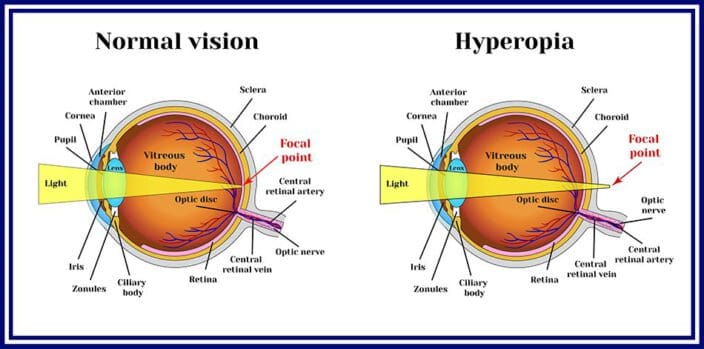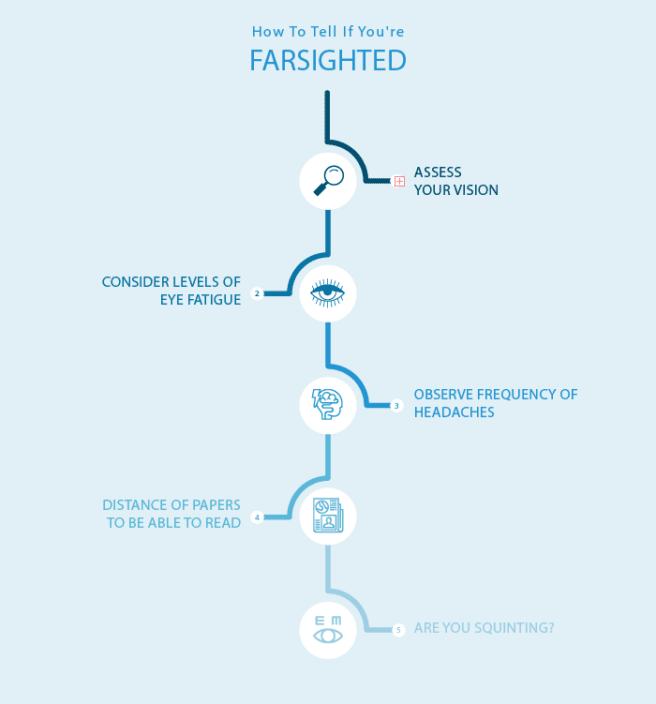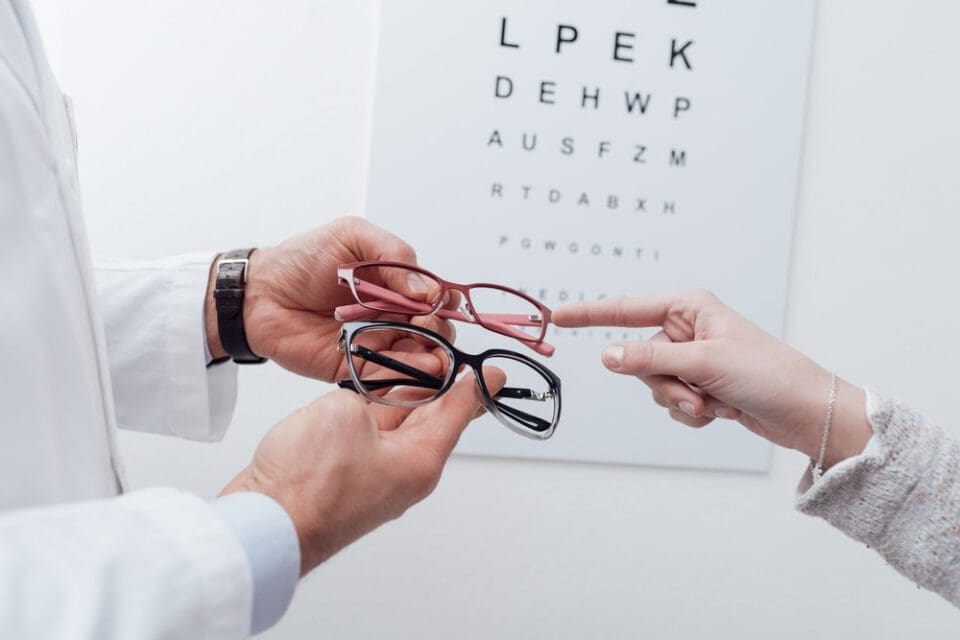How to Tell if You Are Farsighted (5 Quick Steps)
Home / Farsightedness (Presbyopia) /
Last Updated:
Farsightedness is a refractive condition that the National Eye Institute reports between 5 and 10 percent of Americans have. Farsightedness causes close things to appear blurry, while things far away may still be in focus.
Table of Contents
There are two forms of farsightedness:

- Hyperopia: Most people with hyperopia are born with it. It relates to the cornea being too flat or the eyeball being too short.
- Presbyopia: This impacts people around age 40 and is also referred to as “aging eyes.”
Both types of farsightedness can make it difficult to read or see objects clearly up close. Farsightedness can cause headaches, eye strain, and potentially lead to accidents or injuries if you can’t see well enough to perform daily tasks.
There are some indicators you can look for to recognize that you may be farsighted, such as blurry vision when trying to read, holding things farther away from your eyes to see them more clearly, fatigue, and headaches.
Once you realize you may be farsighted, it is time to see an ophthalmologist who can perform a comprehensive eye exam that will indicate your degree of farsightedness and the best treatment options for you. Corrective eyewear like contacts or glasses and laser corrective eye surgery are treatment options for farsightedness.

Steps for Recognizing Farsightedness
A refractive error is when the light being bent in your eye isn’t falling into the right place for clear images to appear. In the case of hyperopia (farsightedness), this is due to the cornea not being steep enough or the eyeball being too short, which can cause light to be focused behind the retina instead of directly on it.
Hyperopia is hereditary. Mayo Clinic reports that most people are born with it and that it commonly runs in families.
You deserve clear vision. We can help.
With 135+ locations and over 2.5 million procedures performed, our board-certified eye surgeons deliver results you can trust.
Your journey to better vision starts here.
Presbyopia impacts virtually everyone beyond age 50, and the American Optometric Association (AOA) publishes that the average onset of the condition is between ages 42 and 44.
With presbyopia, the lens of the eye is affected as it becomes stiffer and less flexible with age. The muscles used to constrict the lens to focus on objects up close become more strained and less effective. Both cases of farsightedness can have similar symptoms.
Here are five steps to help you recognize farsightedness:

- Assess your vision. Typically, in the case of farsightedness, you will struggle to see things clearly up close, such as fine print, and you may start to have trouble reading newspapers and menus. If you suffer from extreme farsightedness, however, you may not be able to focus clearly on anything near or far. Blurry vision, either near or far, can be a sign of farsightedness.
- Consider levels of eye fatigue. By the end of the day, you may start to experience fatigue, and it can become difficult to see things up close clearly. You may rub your eyes a lot and strain your eyes to bring things into better focus. Your eyes can often correct for mild farsightedness themselves, which is called accommodation, and you may not even recognize that a problem exists until you get tired. When this happens, your eyes will have a hard time making up for the refractive error, and images and text can become blurry. If you start to experience blurry vision when you are tired, it could be a sign that you may suffer from some level of farsightedness.
- Observe frequency of headaches. Constantly straining your eyes to bring things into focus can cause chronic headaches. You may notice that after a day of looking at text, reading or working intently on a computer, you experience headaches. This can be related to the fact that your eyes are working hard to accommodate for farsightedness. You may also experience burning or aching around the eyes.
- Consider how far away you hold papers in order to read them clearly. Presbyopia is a progressive disease. Mayo Clinic explains generally starts to become noticeable around your mid-40s and can continue to worsen up until about your mid-60s. As you start to struggle to see text clearly up close, you likely try to hold things further away from your eyes to bring it into focus better. This can be a sign that you are starting to develop farsightedness or that you are already struggling with presbyopia.
- Assess how often you squint. Presbyopia often involves the inability of the muscle fibers attached to the lens of the eye to effectively constrict the lens to focus on nearby objects, so you may try to make up for that by squinting. You may also struggle to see things as well in low-light situations and will try to squint in these environments to bring things into focus. Squinting to try and see better is often a sign of a refractive error such as farsightedness.

Farsighted Diagnosis and What Comes Next
Mild farsightedness often corrects itself as the eyes can accommodate for the refractive error without official corrective measures. You can help to eliminate eye strain and headaches by resting your eyes when they get tired and giving them a break from screens or looking at objects or text up close for too long.
Again, presbyopia is a progressive condition. While you may initially be able to get by with “readers” from the drugstore, it will likely continue to worsen and will eventually require prescription eyewear or corrective surgery.
If you recognize the signs of farsightedness, it is important to see your doctor for an eye exam. The traditional chart-reading exam is not often enough to catch farsightedness, but a complete eye exam that includes a refraction assessment can diagnose it. With a comprehensive eye exam, the American Academy of Ophthalmology (AAO) publishes that specialized instruments are used to measure the level of reflection of light on the retina and the level of refractive error that is present.

Both prescription eyeglasses and contacts can also account for distance vision issues, such as myopia (nearsightedness), and multifocal lenses or bifocals can be helpful. Monovision LASIK (laser-assisted in-situ keratomileusis) or monovision contacts correct one eye for distance and the other for close-up vision clarity; they can be options for multiple refractive errors as well. LASIK and PRK (photorefractive keratectomy) are surgical options for correcting farsightedness.
Another solution, especially in the case of presbyopia, is a clear lens exchange or refractive lens exchange (RLE) procedure that involves the implant of an artificial intraocular lens (IOL). This replaces your current lens with a new and more flexible one.
Your doctor can help you determine what your next steps should be and how to best address your level of farsightedness.
You deserve clear vision. We can help.
With 135+ locations and over 2.5 million procedures performed, our board-certified eye surgeons deliver results you can trust.
Your journey to better vision starts here.
Hypermetropia: Is It Different From Hyperopia?
If you are concerned about farsightedness, you may have started researching hyperopia or presbyopia online. As you find results for hyperopia, you may also run across the term hypermetropia.
Hypermetropia is basically another term for hyperopia, which is a form of farsightedness not related to aging. In contrast, presbyopia is farsightedness that occurs as the eyes age. This is separate from other refractive errors you may have, like astigmatism. Many medical journals may use the terms hyperopia and hypermetropia interchangeably.
Hypermetropia is a more archaic term for farsightedness. While myopia, or nearsightedness, has been understood since ancient times because it is a much more common refractive error, farsightedness or hyperopia/hypermetropia has only been classified as a measurable, correctable medical condition since the 19th century. German eye doctor Donders began exploring the measurable difference between hyperopia (or hypermetropia) and presbyopia around 1860, when he began to properly classify the difference based on explorations by previous optometrists and ophthalmologists.
His classifications of eye conditions included:
- Emmetropia, or an eye with standard vision.
- Brachymetropia, a measurement of vision in front of the eye, or myopia or nearsightedness.
- Hypermetropia, vision measured behind the eye, or hyperopia.
Eyes that are not emmetropic are ametropic, or unhealthy. Measuring a second point of vision either in front of or behind the eye helped Donders describe where the retina and lens struggled to refract light to create a clear image.
Hypermetropia describes “morbidly long sight,” or an eye that is not spherical for clear vision but too flat at the front or back and considered too small. While this is an inaccurate physical description based on the best medical understanding right now, it was a 19th century theory regarding why a small percentage of the population developed trouble seeing objects closer to their faces rather than farther away.
In some early historical cases, hypermetropia also described presbyopia, the changes in the eye causing trouble with close-up vision as the individual got older. However, this conflation fell out of favor. Instead, hypermetropia became associated specifically with hyperopia, thanks to Donders.
Other medical professionals at the time used other terms, including hyperopia, to describe farsightedness that is not caused by aging eyes. Over the last 100 years, hyperopia has been considered more medically accurate and is used more often.
In some instances, the term hypermetropia may be used instead. It is not an inaccurate term; it’s simply an older one, which is falling out of favor.
If your ophthalmologist or optometrist uses this term, you can ask for clarification, but it typically refers to standard farsightedness, which can be corrected with a prescription for glasses or contact lenses. If you prefer, you may be eligible for LASIK if your refractive error is not changing too much per year.
Living With Farsightedness Frequently Asked Questions
What is farsightedness?
People who are farsighted have difficulty seeing objects up close.
What causes farsightedness?
Farsightedness is generally caused by a short eyeball or stiff cornea. Either issue can trigger problems with how light bends and focuses on the retina, resulting in blurry up-close vision.
Is farsightedness always associated with aging?
No, farsightedness is a common part of the aging process, as a good portion of the population needs reading glasses as they get older. But farsightedness can also be the result of irregular eye shape at birth.
How is farsightedness treated?
Corrective lenses, like reading glasses or contact lenses, are often prescribed to correct farsightedness. Laser eye surgery offers a more permanent fix to farsightedness.
You deserve clear vision. We can help.
With 135+ locations and over 2.5 million procedures performed, our board-certified eye surgeons deliver results you can trust.
Your journey to better vision starts here.
References
- Facts About Hyperopia. (July 2016). National Eye Institute.
- Farsightedness. (June 2018). Mayo Clinic.
- Care of the Patient With Presbyopia. (2011). American Optometric Association.
- Hyperopia or Farsightedness. College of Optometrists in Vision Development.
- Presbyopia. (December 2017). Mayo Clinic.
- Farsightedness: Hyperopia Diagnosis. (March 2017). American Academy of Ophthalmology.
This content is for informational purposes only. It may have been reviewed by a licensed physician, but is not intended to serve as a substitute for professional medical advice. Always consult your healthcare provider with any health concerns. For more, read our Privacy Policy and Editorial Policy.
